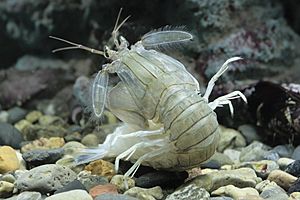Japanese mantis shrimp facts for kids
Quick facts for kids Japanese mantis shrimp |
|
|---|---|
 |
|
| Scientific classification | |
| Synonyms | |
|
The Japanese mantis shrimp, also known as Oratosquilla oratoria, is a special type of mantis shrimp. You can find it living in the Western Pacific Ocean. In Japan, it's called shako (シャコ, 蝦蛄) and is a popular food, especially in sushi.
Like other mantis shrimp, it has a very strong "spear" arm. It uses this arm to catch its food, which includes small invertebrates and tiny fish. This shrimp can grow up to 18.5 centimeters (about 7 inches) long. It usually lives in the ocean at depths from 10 to 100 meters (about 33 to 330 feet).
Contents
What Does It Look Like?
The Japanese mantis shrimp is usually light grey or light brown. It has dark red lines along its body, from its chest to its tail. The very tips of its back end are dark green.
Where Does It Live?
Japanese mantis shrimp live in many different places. You can find them near shores, in coral reefs, and on flat parts of the ocean floor. They are originally from the Northwestern Pacific Ocean. This includes the waters near Korea, Japan, Taiwan, China, and Vietnam.
Recently, these shrimp have also been found in Australia and New Zealand. They were brought there by people and are now considered an invasive species. This means they are not naturally from those areas and can sometimes cause problems for the local environment.
These shrimp dig long, U-shaped burrows in soft sand or mud. They use their special mouthparts to dig these homes. During the day, they stay hidden in their burrows to be safe. They usually only come out at night to hunt for food. Their burrows are also important for laying eggs. If a burrow is too small, the female shrimp might not lay eggs. So, they will make their burrow bigger or dig a new one that fits better.
How It Hunts and What It Eats
The Japanese mantis shrimp is a hunter. It actively searches for and catches its prey. At night, it leaves its burrow to find food. It then brings the food back to its burrow to eat.
This mantis shrimp is special because it uses two different hunting styles. Some mantis shrimp are "spearers" and use their sharp claws to stab soft-bodied prey. Others are "smashers" and use a club-like arm to break open hard-shelled prey. The Japanese mantis shrimp does a bit of both!
It eats many different things, depending on where it lives. Its diet can include:
- Other crustaceans (like crabs)
- Molluscs (like snails or clams)
- Small rays
- Small fish
- Worms
- Even algae
Sometimes, if there isn't much food, they might even eat smaller mantis shrimp of their own kind.
Reproduction and Life Cycle
Japanese mantis shrimp reproduce when a male and female, both grown up, find each other. Female mantis shrimp are ready to have babies from late spring to early summer, and this lasts until fall. Males can reproduce all year round.
They have some interesting ways of showing they want to mate:
- Antenna Stroking: The male and female face each other and gently stroke each other's antennae for a few seconds.
- Pair Walking: They might walk very close together, side by side.
- Brushing: The male might gently brush the female with his legs.
After the eggs are fertilized, the female lays them inside her burrow. She then takes care of the eggs until they hatch. Females spend a lot of time nursing their eggs. Because of this, they rarely leave their burrows, except to find food. When a female does leave her burrow, she often carries her eggs with her mouthparts to keep them safe. Just before the eggs hatch, the female might start leaving the eggs more often to feed herself.
The eggs usually hatch in about 14 days. After hatching, the baby mantis shrimp go through 11 different stages as larvae. They start actively swimming and eating when they reach the third larval stage. The larval stage lasts about 32 to 51 days. After this, they become young mantis shrimp, called juveniles.
Japanese Mantis Shrimp in Food
The Japanese mantis shrimp is mostly eaten in Japan. It's not as popular in other countries because it can be expensive and hard to find.
It tastes best in the spring, which is its breeding season. Sometimes, it's eaten with its roe (eggs), which are also considered a treat. People say its taste and texture are a mix between eel and shrimp.
Shako started appearing as sushi in the 1950s. It was often brushed with a sweet sauce called nitsume and served as nigiri (a slice of seafood on top of rice). Originally, shako was prepared by boiling it in a sugar syrup. But now, it's usually simmered slowly. This method helps it stay fresh for longer.
Gallery
See also
 In Spanish: Oratosquilla oratoria para niños
In Spanish: Oratosquilla oratoria para niños




